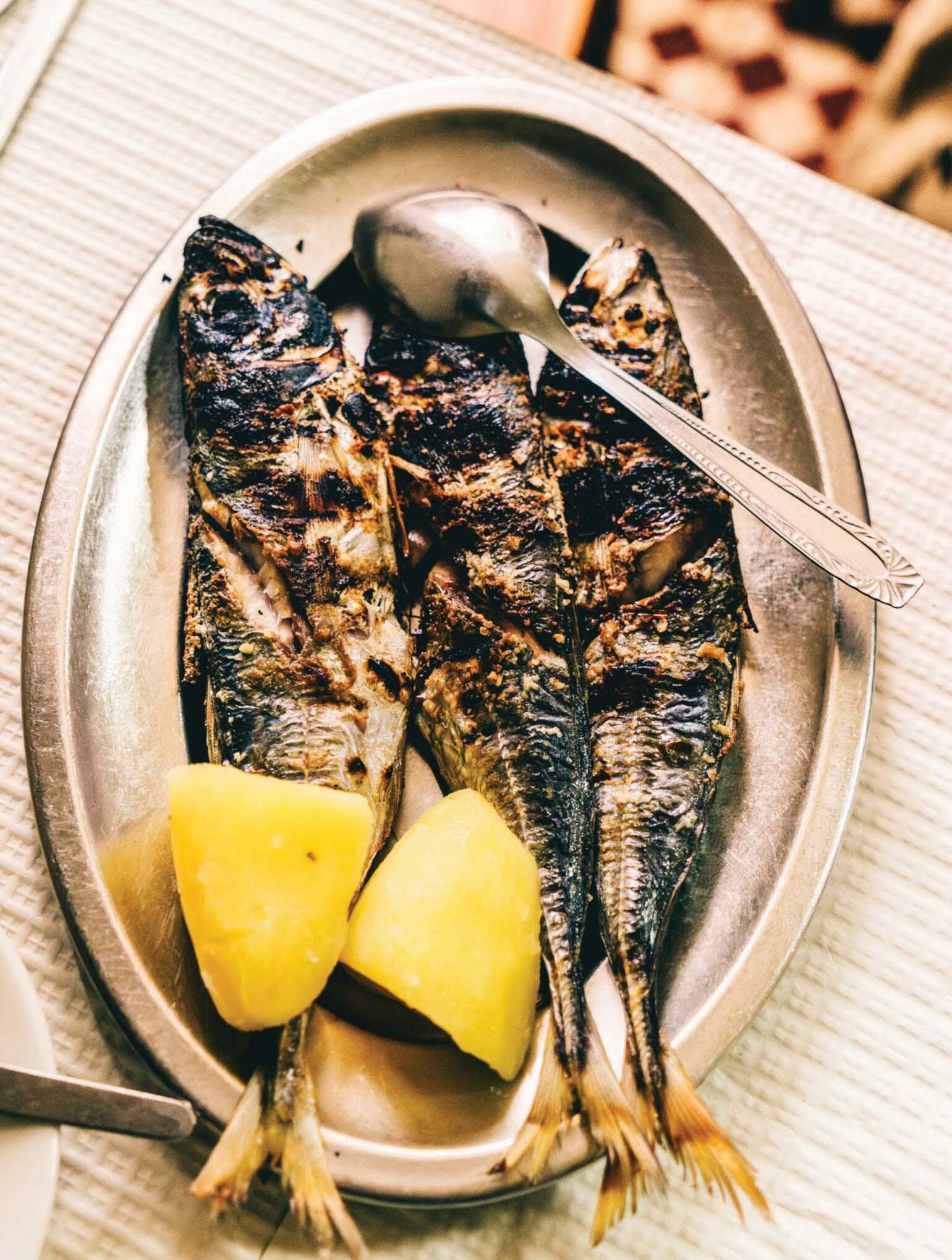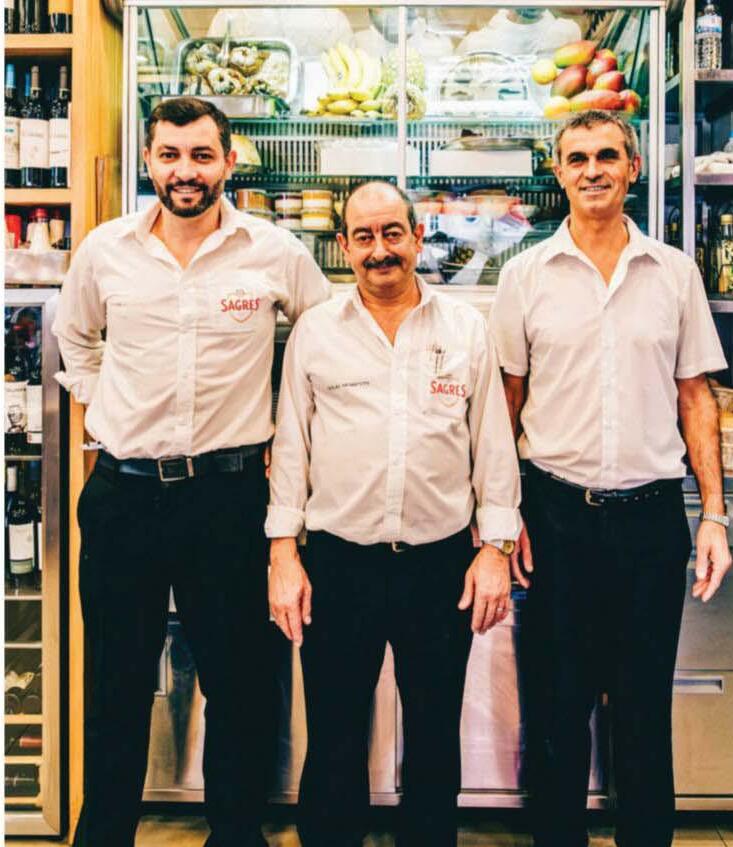Denemek ALTIN - Özgür
HAPPY MEAL
Travel+Leisure US
|December 2024/January 2025 (Double issue)
Many tascas, the no-frills dining spots in Lisbon, have vanished. But others, Austin Bush discovers, are being lovingly reinvented.

YOU KNOW WHAT a bistro is. If hard-pressed, you could probably define trattoria, too. But how about a tasca? That question was on my mind as I ate lunch at Tasca do Gordo (or "Fatty's Tasca"), a no-frills canteen on Lisbon's waterfront.
Housed in a windowless concrete building, the interior was just as plain: white tiles, bright lighting, red plastic chairs. But the place was packed with construction guys, office workers, families, and buddies on lunch dates.
"Tascas are for sustenance, not for opulence," said the food historian and chef André Magalhães, who is my go-to when I want to learn more about Portuguese cuisine. He was drizzling chili oil over dobrada tripe braised with white beans and served in a terra-cotta bowl. Between bites, Magalhães gave me a quick lesson on the tasca's humble beginnings.
 In 1755, he explained, Lisbon was flattened by an earthquake, which was immediately followed by a tsunami. To rebuild, laborers were recruited from Portugal's far north and Galicia, in northwestern Spain. They came in great numbers. Over time, some of those working as carvoeiros, or charcoal vendors, opened shops that sold wine and, eventually, one-pot dishes, like the tripe and bean stew Magalhães and I were enjoying. And so the tasca was born.
In 1755, he explained, Lisbon was flattened by an earthquake, which was immediately followed by a tsunami. To rebuild, laborers were recruited from Portugal's far north and Galicia, in northwestern Spain. They came in great numbers. Over time, some of those working as carvoeiros, or charcoal vendors, opened shops that sold wine and, eventually, one-pot dishes, like the tripe and bean stew Magalhães and I were enjoying. And so the tasca was born."Any person who needed to count his pennies would go to a tasca," he said.
During the 20th century, tascas dotted every neighborhood of Lisbon, serving as affordable lunchrooms for the working class. They also became associated with homestyle Portuguese cooking, using everyday ingredients like salt cod, sardines, and potatoes.

Bu hikaye Travel+Leisure US dergisinin December 2024/January 2025 (Double issue) baskısından alınmıştır.
Binlerce özenle seçilmiş premium hikayeye ve 9.000'den fazla dergi ve gazeteye erişmek için Magzter GOLD'a abone olun.
Zaten abone misiniz? Oturum aç
Travel+Leisure US'den DAHA FAZLA HİKAYE

Travel+Leisure US
CHASING SUMMER
On a trip to Maine's Mount Desert Island, Dinaw Mengestu had an ambitious, high-energy itinerary. Then his family reminded him what quality time is all about
13 mins
July 2025

Travel+Leisure US
Charging Ahead
After giving up on strenuous cycling vacations, Kathy Roberson goes for one more ride-this time with an e-assist.
3 mins
July 2025

Travel+Leisure US
THE SILK ROAD BY RAIL
Uzbekistan's cultural gems are becoming more accessible with new trains. Photographer Francesco Lastrucci discovers enchanting mosques and the locals' genuine hospitality along the way.
3 mins
July 2025

Travel+Leisure US
Pushing the Limits
Getting out of your comfort zone is the latest frontier in luxury travel.
3 mins
July 2025

Travel+Leisure US
GUYANA IN FOCUS
Photographer Ike Edeani captures the wild beauty of a secluded South American frontier.
4 mins
July 2025

Travel+Leisure US
The Mekong’s Moment
Southeast Asia is back in the spotlight as developments along this storied river make Cambodia, Laos, and Vietnam more alluring than ever.
3 mins
July 2025
Travel+Leisure US
Skip to the Good Part
Rather than making a multiday crossing of the infamous Drake Passage, travelers are increasingly flying over it, straight to Antarctica.
2 mins
July 2025

Travel+Leisure US
Living on the Edge
On an expedition to the remote Tierra del Fuego, at the southernmost tip of South America, Michael Snyder gets a taste of life as a homesteader.
5 mins
July 2025

Travel+Leisure US
MAKING SPLASH
On a two-day expedition down one of California's most spectacular—and thrilling—waterways, David Amsden tries river rafting with a luxurious, gourmet twist
8 mins
July 2025

Travel+Leisure US
TURNING THE TIDE
With its untamed beauty and irrepressible spirit, the Philippines offers fresh discoveries around every corner. Jeff Chu returns to find a nation stepping boldly into its future.
14 mins
July 2025
